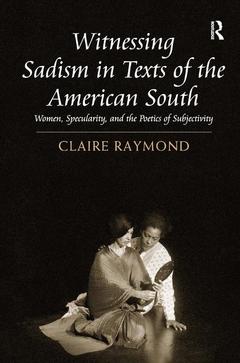Witnessing Sadism in Texts of the American South Women, Specularity, and the Poetics of Subjectivity
Auteur : Raymond Claire

Date de parution : 05-2014
15.6x23.4 cm
Disponible chez l'éditeur (délai d'approvisionnement : 14 jours).
Prix indicatif 177,01 €
Ajouter au panierThème de Witnessing Sadism in Texts of the American South :
Mots-clés :
Young Men; American South; Big Sweet; Dickinson's poetry; Jack Shainman Gallery; sadistic violence; Harvard’s Peabody Museum; Southern Agrarian critics; Mary Fortune; American women's literature; Witness Figure; Feminine Witness; Dickinson’s Poetics; Weems’s Work; Sadistic System; Enslaved Body; Feminine Speaker; Morrison’s Beloved; Dickinson’s Poem; Dickinson’s Poetry; Southern Women’s Writing; Candy Darling; De Blainville; Jesuit Meditations; Jim Crow South; Intersex Person; Peabody Museum; Hidden Witness; Sacrificed Daughter



